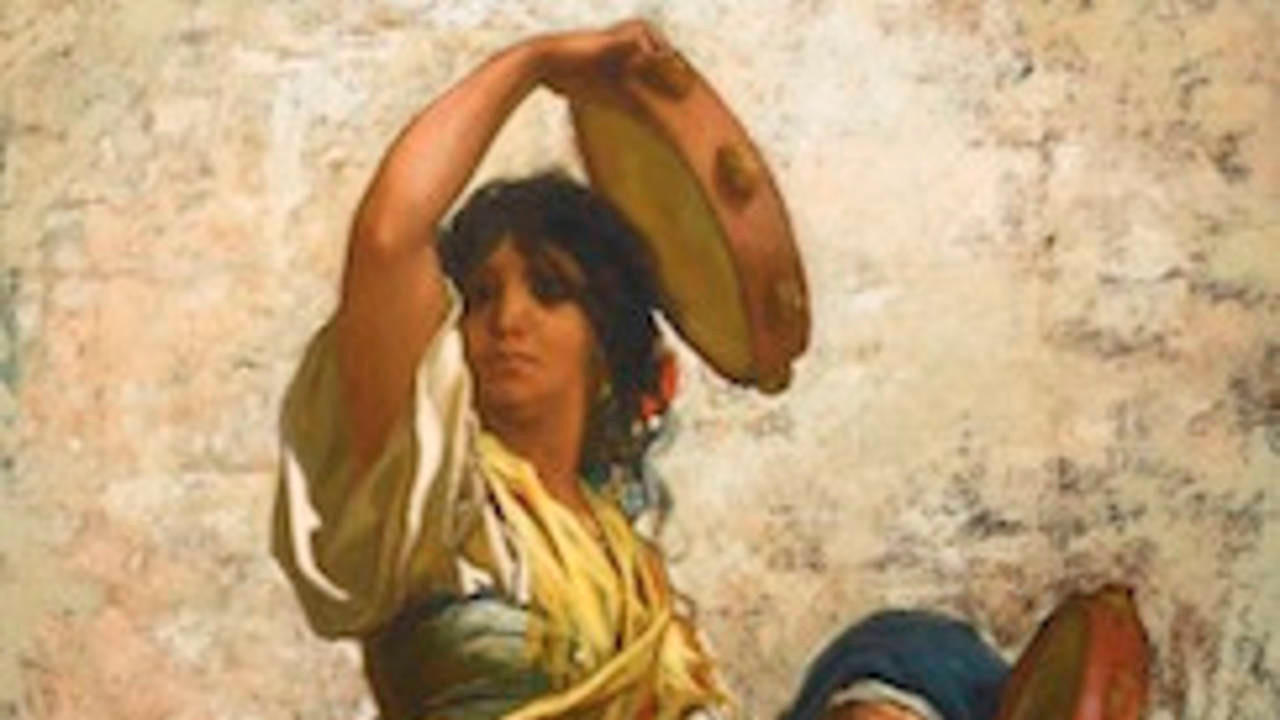When did Flamenco add shoes?

The beautiful dancer & teacher Najmah has send us two great questions: When did Flamenco add shoes? and Was it just men’s thing first?
Let's explore some answers...
When did Flamenco add shoes?
There is not an exact date and time when people began using shoes as an artistic prop in Flamenco. It was rather a gradual process.
During the 1800s we find numerous examples of Flamenco being danced barefoot. Then, later, when Flamenco was performed on the stage, women wore shoes, but for a long time they barely did any footwork.  This is the earliest photography of Flamenco dancers I have found. It dates from 1862, taken by the Charles Clifford, who was Queen Victoria of England royal court photographer.
This is the earliest photography of Flamenco dancers I have found. It dates from 1862, taken by the Charles Clifford, who was Queen Victoria of England royal court photographer.
In this photo, we cannot see whether most dancers are wearing anything on their feet as their long dresses cover them. But we can see that the guitar player and the dancer on the right are not wearing Flamenco shoes. They are wearing some form of what we call in Spain alpargatas (similar to flat espadrilles) which is what the poor people in Spain wore. Yet, that was one level above, going around barefoot. 
It is important for us to understand the socio-cultural context of the time. During centuries, most Spaniards lived in misery! Even though there were tons of gold arriving from the Americas, the gold and the wealth was taken and enjoyed by the royal families and few other families surrounding them, while many Spaniards lived in utmost poverty.
Even though in the 1800s, the middle class was growing in Spain, many people (especially the Gitano population) were not able to afford shoes to wear in daily life, let alone purchasing expensive shoe to dance in them!
During 1862 and 1873 we find numerous illustrations and paintings of Barefoot Flamenco. Many of them were masterfully done by the great French illustrator Gustave Doré, who along with the aristocrat hispanist Jean Charles Davillier traveled in Spain producing fascinating articles for the renowned travel magazine Le Tour du Monde.

As we can see in the above illustration, Doré also documented other types of dances that coexisted with Barefoot Flamenco. Those Dances were called Bailes de Palillos, sometimes associated with the Escuela Bolera (danced with ballet slippers), which arose from French influence on popular dances of Spain.
This photo was taken during the 1880s when Flamenco began to be shown on the stage. Even though we cannot see the feet of the performers, we can safely assume that they are wearing some form of shoes.
Wearing shoes, at that time, was a sign of wealth, sophistication, and social status. But based on this historic photo, we cannot be sure if they wore yet Flamenco shoes as we know them today.
A few years ago, I conducted and interview with award-winning Flamenco scholar and author Juan Vergillos, at the Centro de Documentación del Flamenco in Jerez de la Frontera (Spain). Vergillos told me that he had found newspapers from 1945 expressing controversy about the putting nails on the shoes to strengthen the sound, which makes him think that using Flamenco shoes is quite a recent occurrence.
Whatever the case, even though women wore shoes on the stage, for the most part, they barely did any footwork. Women danced with their hips, their torso, their arms, their fans, their shawls… In short, their dance was a spellbinding display of their feminine charm (it was called “Baile de Mujer”).
Was it just men’s thing first? 
Yes, originally, in Flamenco, footwork is male dancing, not female dancing. Footwork was just a men’s thing for a long time. There were a couple of women, such as the famed La Cuenca and Salud Rodriguez, who, in the late 1800s, dared to dance dress as men and did some footwork. But these two women were the exception, not the rule.
It is also important to understand that the original footwork was far from the fierce machine-gun footwork we see these days. Author Fernando el de Triana, in his book Arte y Artistas Flamencos describes their footwork as filigranas (filigree) or “encajes de bolillos,” (bobbin lace) which is intricate, but very delicate.
Paradoxically, the dancer who revolutionized Flamenco footwork was not a man, but a woman: Carmen Amaya (1918 –1963). She was called a “Human Tornado.” Her footwork was stronger and faster than any man had ever seen. She was phenomenal and her international success was astonishing.
Soon, other female dancers began imitating Carmen’s strong and fast footwork. That pretty much marked the end of pure Feminine Flamenco on the stage. At the most, these days we see a hybrid dance where women alternate sections of masculine footwork with feminine arm work, fan, shawls or some skirt work.
In conclusion, I would say that since the 1930s theatrical Flamenco dancing has increasingly become a footwork-based dance. Yet, dancing Flamenco with shoes is not a “Law,” it is a choice each dancer makes.
About the Author
 Native Spaniard, Puela Lunaris, who holds a B.A. in Dance Education and Spanish Language and Culture from the State University of New York, mentors dancers and musicians in creating their own unique Flamenco Fusion project to stand out in the crowd.
Native Spaniard, Puela Lunaris, who holds a B.A. in Dance Education and Spanish Language and Culture from the State University of New York, mentors dancers and musicians in creating their own unique Flamenco Fusion project to stand out in the crowd.
Through her interactive online courses, she offers Choreographer & Teacher Certifications as well as quality educational materials based on her extensive research about dances of Morisco, Gitano, and Sephardi origins from her native Spain, especially Zambra Mora, Spanish Skirt Dance, and Barefoot Feminine Flamenco.
©2019 Puela Lunaris. All Rights Reserved. Please note that this is a fully copyrighted material. It may be reprinted by permission: All you need to do is contact Puela and let her know where do you wish to publish it. Citations may be extracted from this article. Please give full credit to this web site by posting an active link to the original article. Thank you!
Click here to read a fascinating, in-depth article about Barefoot Flamenco.
FREE Virtual Tour
Flamenco as a Living Ritual
Discover Flamenco as a living tradition
in our upcoming documentary ¡Zambomba!





